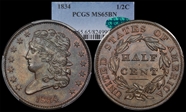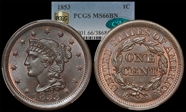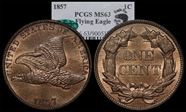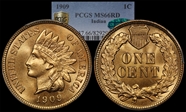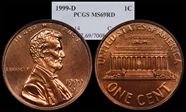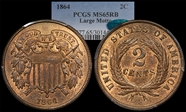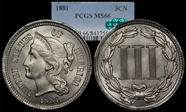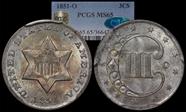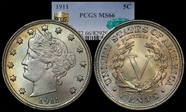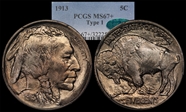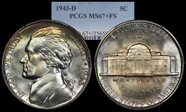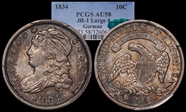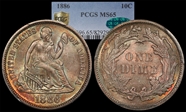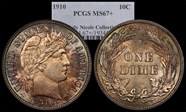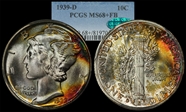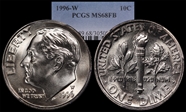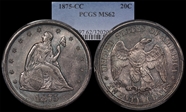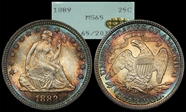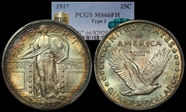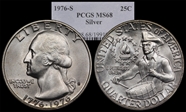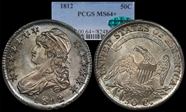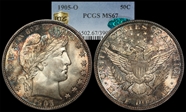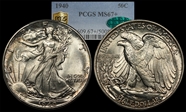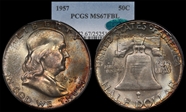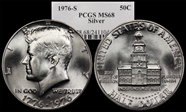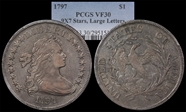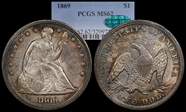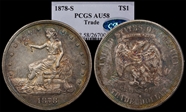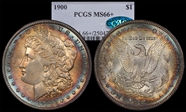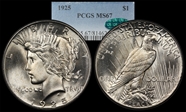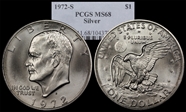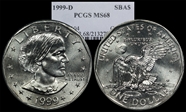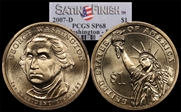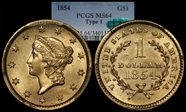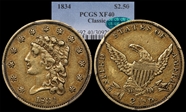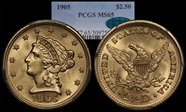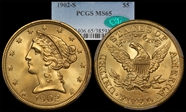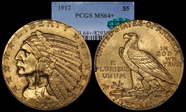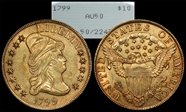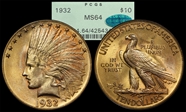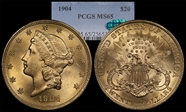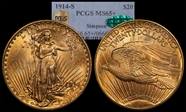orifdoc 的钱币相册
This coin has quite a bit of red showing in protected areas. Detail is outstanding and surfaces show no distracting marks on a nice, even planchet.
Large cents with great luster are really fun. This coin has an awful lot of red for a "BN" coin, especially over the reverse. Detail is incredible and there are no distracting marks. For type, it would be hard to do better.
Well-struck and exceptionally nice for grade. Some planchet striations are visible. Nice luster twirls around in-hand. From Rick Snow.
Some coins are tremendously enjoyable beyond what can be described by a numerical grade. This one looks like it was pulled from a fresh roll yesterday. Sharp strike, even, smooth coloration and no distracting carbon spots make it truly exceptional. From Dave Wnuck.
Roughly one-half trillion Lincolns have been produced. Almost none have a level of detail and strike quality to compare with this one. Deep, flashy luster completes the effect. This little coin represents the pinnacle of the US Mint's 20th Century business-strike craftsmanship.
This is an odd coin with what looks like two reverse designs to me. More lustrous than I'm able to capture in a photo. Lots of red for a coin made during the Civil War. From Mark Feld.
The three-cent nickel is a bit of an oddity and the series is somewhat unpopular with current collectors. While the reverse design is a bit uninspired, the obverse features one of the nicest depictions of Lady Liberty to grace our coinage. This example is stellar with sharp detail, deep luster, and clean surfaces.
I love the "O" mint mark on this coin. This issue is the only 3-cent silver not minted in Philadelphia. This example sports really flashy luster and a golden center over a steel-blue background.
Somewhat like the two cent coin, the design of the shield nickel is somewhat unusual. This example sports really nice luster and sharp detail. There is a bit of light toning and a few die polish lines are evident on both sides.
This little coin is an absolute jewel. Glacier-blue toning meets gold against the rim and violet-rose hues over the portrait. In-hand luster really pops. The little toning spot below and to the left of the V is only visible at certain angles.
The buffalo nickel is an American classic, and arguably the most successful of the "Renaissance" coins in terms of public recognition and uniform appeal. This example is stellar, with sharp detail, beautiful color, and flashy luster.
The added silver gives war nickels a different look with deeply lustrous surfaces and nice patina. This example demonstrates reverse die polish lines and exceptional detail.
Minted five years prior to Washington's death, the 1794 half dime is rare in all grades with only 7,756 coin minted. While not in a high state of preservation, it demonstrates adequate detail and a pleasing patina. Die cracks are abundant. The lack of denomination is reminiscent of a more sensible age. Think of where it has been!
The small date variety is identified by the flat-top "1". I have always loved the no-stars variety as these coins are like miniature Gobrecht dollars. This example is extraordinarily nice for the assigned grade. Luster is outstanding and the patina radiates nice shades of green and gold.
This little coin is a fantastic representative of type with no distracting marks and superb detail. It shows layers upon layers of originality and just a trace of wear, primarily discernible from a few faint contact lines. Luster pops through the patina. From the recently auctioned Gorman collection of Capped Bust Dime varieties which contained 122/123 of the known die marriages.
Well-struck, lustrous, and great eye appeal with blazing orange and rose surfaces. For a type coin, it's hard to do better.
Ex. Duckor. This little coin is just incredible with sharp detail and virtually perfect surfaces. Brilliant luster erupts through a nice golden patina. One one example has graded higher, a beautiful 68+ from the Simpson collection.
The talents of Mr. Weinman are masterfully displayed in this timeless renaissance design. This superb jewel sports blazing, penetrating luster that boasts vibrant splashes of color. One trivial hit on the fasces is all that keeps this coin apart from the finest known in the entire series.
This 1996 issue is the first and only US dime to feature a W mintmark. The 1996-W also has the lowest mintage within the Roosevelt series. This example is well-struck with nearly perfect surfaces.
The dip bucket spared only a few Seated Liberty coins and most double-dimes are dull, boring things. This little example shows a nice patina, attractive color, adequate luster, but a bit of softness in the central devices. One is allowed a few compromises to include issues from the smaller mints.
Early bust type is cool no matter what it is. This piece is as close as I'll ever get to a 1796 quarter. It's nice, with only a single well-concealed hit in Liberty's top curl. From Gary Adkins.
Many of the late-date seated quarters had low mintages and this coin is one of only 12,000. This particular specimen is a magnificent representative with deep radiating luster and excellent detail. Obverse and reverse patina is perfectly matched and features champagne centers deepening to electric blue at the rims. Detail is complete. From Tom Bush.
A very special coin that just glows in-hand. This sort of coin makes me wonder about people who don't like toning. Ex. Dale Friend.
What a wonderful, gorgeous, stunning coin! Eye appeal is off the charts. SLQ's simply do not come like this. The coin is hammered, insanely lustrous, and technically excellent. Some examples might be graded higher, but it would be virtually impossible to find one better. From Tom Bush.
A nice coin with an almost satin-prooflike obverse and a lustrous reverse.
I decided to look for a common-date CBH for my type set and was going through lots at a Heritage Auction when this one popped up. The deep luster of this piece drew me in, and somehow I ended up with an early coin, full of character. O-103.
This coin is a fabulous example of type, with great originality, sharp detail, and deep, beaming luster. We owe a large debt to prior generations who safeguarded treasures like this one.
The Barber Half is the most difficult coin in a 20th Century type set. Gem examples are common, but coins at the MS67 level become quite scarce. This example sports an incredibly nice strike for any Barber half and detail is particularly nice for a New Orleans coin. All of the stars have sharp centers, with only the eagle's left foot and upper-right corner of the shield showing only the slightest weakness. Cartwheel luster is exceptionally bright and lively. Nice color adds considerably to the eye appeal with nice blues and pinks, and soft peach tones over the portrait. Pull-away toning is notable around devices on both sides. One of my favorites.
Walkers are some of my favorite coins, especially the early dates. For a type coin, this one makes the cut. The design is easily in my top 5 of all US coins. This example is well-struck with just a bit of typical weakness on the hand and chest of the eagle. Luster in-hand is really nice and cascading. A bit of rim toning adds to the effect.
The Franklin Half is a strange coin, with a ridiculously small eagle and flat, bland obverse. The coin honors a great American and fits squarely between the beautiful Renaissance Walking Liberty and the modern politician Kennedy design. This example is superb, with deep luster emanating through fantastic color. From Larry Shapiro.
Perhaps the most lusterous, flashy silver coin in my collection. This example is a nice example of what a Kennedy Half should be.
The duration of the hunt for this coin set a new personal record. Small Eagle dollars aren't terribly difficult to locate, but good luck finding nice ones! The present example is nice for the grade and, apart from a small rim bump, is free of any distractions.
In general, I prefer the clean look of the no-motto dollars but this example is stunning. Like most coins of this era there is a good chance it was dipped, but if so, it has returned with outstanding color. Luster and eye appeal are quite nice for the assigned grade. From a Heritage auction via Mark Feld.
This is my kind of AU58! There is almost no wear and no distracting features apart from a few scattered hairlines on the obverse. Really tremendous color in-hand.
For some reason I prefer Peace Dollars, but this Morgan is a great example. Strike is slightly soft, but the toning and surfaces are nice.
Wow, what a coin! Peace dollars like this one are few and far between. This is the only Peace dollar I've personally seen with NO frost breaks. One little reedmark in the hair is the only visible flaw. Interesting die polish is noted around "IN GOD". From Larry Shapiro... He liked it so much it's featured in the logo of his website. ;)
A failure by any standard, this little coin was unpopular the moment it was issued. The borrowed reverse and poor Ms. Anthony's gargantuan forehead did nothing to help its cause. This example is technically excellent, devilishly hard to photograph, and, sadly, seems a sorry end to a beautiful century of our nation's coinage.
The mint got this one right. The design really is fabulous when seen in good condition.
A nice enough issue for the first president, even if his appearance is a little stern.
I'm not really sure why the government feels like we needed this series..... but here it is. Huge open fields and an uninspired design make this one of our least interesting issues.
The little Type I gold dollar is the nation's smallest coin. At a whopping 13mm in diameter, this series would not be a good choice for the visually-impaired. This example sports really nice detail and luster. The obverse would command a gem designation but is held back by the slightly weaker reverse.
This piece has a nice crusty look consistent with its age. In-hand, it also demonstrates about 20 degrees of die rotation. From Gary Adkins.
Nice luster, solid strike, and clean surfaces combine to create a beautiful gem.
Along with the half-eagle, the incuse design of the Indian Quarter Eagle creates a memorable impression. This near-gem example shows sharp detail and nice luster.
From Russ Augustin. One of my favorite pieces. Exquisite for grade with ample luster and no distracting marks.
The Liberty Half Eagle is a coin that spans an incredible range of dates. This 20th Century example sports really nice surfaces and deep, rich luster. It looks as nice as the day it was made.
The iconic Bela Pratt design is an American classic, and the incuse design represents a significant departure from tradition. This example demonstrates full detail and cascading luster over both the raised fields and devices. Only a few upper-right reverse field marks keep it from full gem status.
For me, it was a longtime goal to someday own an 18th Century Eagle. I started looking in 2016 and started seeing what I had been told - that most had been dipped and stripped. Those were nice enough, but lacked the soul that should accompany a 200+ year old coin. A handful of others were beautiful, but outside of my budget in MS grades. Finally, this one showed up and looked to be perfect. It's a BD-2, and is one of an estimated 35-45 extant coins from this die pair. Detail is amazingly sharp with full rims and dentils. Feather and hair detail is complete. A few very light adjustment marks are seen on the shield. Plenty of luster remains and it's quite lively in-hand. By today's standards it would probably grade higher, but it's just fine in the rattler holder. What a treat!
I don't know about you, but to me this is pretty cool. The coin is a fantastic example of type and the holder can't be beat. From RYK.
Liberty Double Eagles are impressive coins which represented an enormous store of value when produced. This common-date example demonstrates booming luster and no significant distractions. It's a true gem in every way.
This coin is just outstanding with rich color and deep luster. The surfaces demonstrate a flashy, pebbly surface that has the feel of old, original gold. The coin was part of the Crawford Collection and eventually made its way to the Simpson collection. It eventually made its way to RYK and I was lucky enough to acquire it from Doug Winter when he sold the bulk of his collection.




















